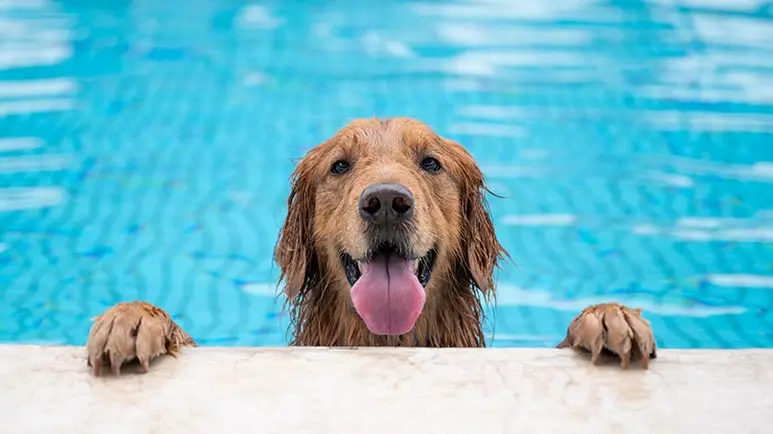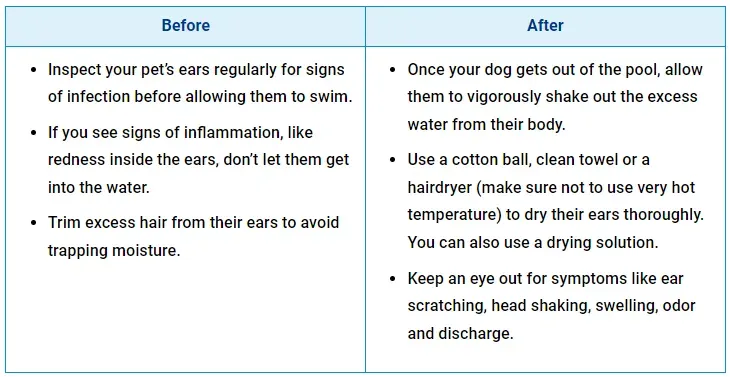Pool Safety Tips Every Dog Owner Should Know
While it may be too chilly in many areas right now for a dip in the pool, knowing these safety reminders by heart will help you (and your pet) stay well-prepared once the warm season comes back.

STORY AT-A-GLANCE
- Not all dogs are natural swimmers. Characteristics like body structure and muzzle shape affect your dog’s swimming ability. Some breeds excel in water, while others struggle and may require life jackets
- Pool chemicals, especially chlorine, can be hazardous to pets, and a 2024 study found that exposure to chlorination byproducts may increase cancer risk in dogs. Consider alternative sanitization methods or reduce chemical use
- Close supervision is crucial for pet pool safety. Teach your dogs how to exit the pool, monitor for signs of fatigue and keep swim sessions short to prevent irritation
- After swimming, proper ear care is essential to prevent infections. Dry ears thoroughly, especially for floppy-eared breeds. Watch for signs of inflammation or irritation
- Basic pool safety includes ensuring pets know how to exit, monitoring water intake, checking for signs of exhaustion and limiting time in chlorinated water to prevent skin and eye irritation
Having a backyard pool can be a delightful treat for pets, especially during hot weather days. Not only is it a great way to exercise and release your pet’s pent-up energy, but it also provides an enjoyable way to cool off when the temperatures rise. However, there are safety reminders you must keep in mind before allowing your pet to spend time in the pool.
Myth — Not All Dogs Are Born Swimmers
Many people believe that dogs are born with the ability to swim. While they may suddenly make paddling motions with their legs when held over water, keep this in mind — while dogs may instinctively try to swim when placed in water, not all of them can safely stay afloat.
A dog’s ability to swim depends on its breed and body structure. Some dogs, like Labrador and Golden Retrievers, Setters, Poodles and Spaniels, have strong hind legs that let them swim efficiently. They are natural swimmers that love to play around enthusiastically in the water.
Meanwhile, smaller breeds like the Maltese and Chihuahuas can swim but may not have the resilience to do so for long periods of time. One reason is that the vastness of the water can make them feel overwhelmed and cause them to panic. They end up tiring themselves out quickly and will desperately do anything to get out of the water – even climbing over you.1
Finally, there are dogs that are just not born swimmers. These are the breeds that have short hind legs, large, square chests and short muzzles. Boxers, Pugs, Basset Hounds and Bulldogs are some examples. Brachycephalic breeds also do not fare well in water. According to an article in Psychology Today:2
“Among the anatomical traits that are typical in non-swimming dogs are flat and short muzzles (the brachycephalic dogs), large and heavy heads, and disproportionately short and stubby legs. If a dog has a flat and broad face (like the Pug or Bulldog) it has to position its body upright in the water in order to keep its nose and mouth above the waterline.
Unfortunately, once the dog achieves this fully or partly vertical position in the water, it becomes immensely more difficult to stay afloat. The dogs with excessively large heads have a similar issue, in that they must adopt awkward swimming positions and have to work very hard to keep their heads above the waterline.”
Hence, if your dog falls under these breeds, then it is important to never leave them unattended and to keep a close eye on them when they spend time in the pool (or at the beach). You may need to use a doggie life jacket to help them stay afloat.
Chlorine — An Unseen Hazard for Pets
It goes without saying that you must never let your pet drink or swallow pool water (or water from the ocean, ponds, lakes and rivers, for that matter). In pools, one particular risk factor is the chemicals used to sanitize the water, particularly chlorine.
While the dangers of chlorine exposure in humans have been proven, there are very few studies about its hazards in pets. However, these hazards do exist, and are just as severe in our animal companions.
One recent example, published in the Veterinary and Comparative Oncology journal,3 found that there’s a significant link between exposure to chlorination byproducts like trihalomethanes (TTHMs), especially bromoform, and an increased risk of canine urothelial cell carcinoma (cancer of the urinary tract). According to the researchers:
“[W]e found significant associations between canine UCC and both swimming pool use and higher municipal drinking water concentrations of chlorination byproducts (TTHMs). These findings are consistent with studies of UCC in people and may represent causal risk factors.
If causative, our findings would support the recommendation that owners of dog breeds at higher risk for UCC, such as Scottish terriers, Shetland sheepdogs, and West Highland white terriers, restrict their dog's access to chlorinated swimming pools, and most importantly, consider installing in-house water filtration units that are rated to remove trihalomethanes.”4
Hence, if you want to keep your pool clean by eliminating bacteria, algae and other organisms, it’s best to swap the chlorine for a milder alternative like bromine. It has drawbacks, however; bromine is not only more expensive than chlorine, but it’s also less stable when exposed to sunlight.
If you want to completely eliminate the use of chlorine and bromine, try doing a maintenance shock treatment every five or six days. This will help get rid of the algae buildup. The shock treatment volatilizes in about 24 to 48 hours, so you and your pet can have several days to use the pool safely.
Reducing the amount of organic material that you carry into your pool is also helpful, as it will reduce the amount of disinfection byproducts. Shower before swimming and teach your children not to urinate in the pool. For your canine pals, give them a good brush and hose them down to remove as much hair and dander before they dive in.
Basic Pool Safety Tips
As with young children, your pets need to be closely monitored every time they go for a swim. Even if you know that your pet is a really good swimmer, it’s better to be more cautious to avoid untoward incidents. Here are some tips to keep in mind:
- Aside from ensuring your dog knows how to swim, make sure they know where and how to get out of the pool, so when they become tired, they can safely let themselves out of the water.
- Pay close attention if your dog loves to splash around with their mouths open or if they gulp water as they swim.
- Be mindful of signs that it’s time to leave the pool. Check if your pet’s eyes are getting a little red, or if they’re coughing or appearing tired from paddling.
- Keep swim sessions short, especially in chlorinated pools. Soaking for too long can lead to skin and eye irritation.
How to Prevent Ear Infections After Swimming
While swim sessions are fun, proper aftercare is important to prevent any unwanted health effects, like ear infections. This occurs when water becomes trapped in their ear canal, and the moisture creates an ideal environment for yeast and bacteria to thrive, leading to inflammation and infection.
Particularly high risk are dogs with floppy ears, like Basset Hounds and Cocker Spaniels, as their ear flaps cover the ear canal, trapping moisture in a warm, dark environment. Dogs with allergies or skin conditions are also at higher risk, as these weaken the ear's defenses against an infection.5 To prevent ear infections, follow these steps before and after swimming:












